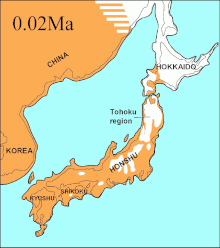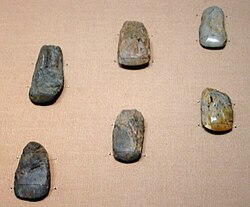
Back العصر الحجري الياباني القديم Arabic জাপানি পুরা-প্রস্তর যুগ Bengali/Bangla Japonský paleolit Czech Japanische Altsteinzeit German Paleolítico en Japón Spanish دوران پارینهسنگی ژاپن Persian Japanin paleoliittinen kausi Finnish Paléolithique du Japon French התקופה הפלאוליתית ביפן HE A paleolitikum Japánban Hungarian
| Japanese Paleolithic period | |||
|---|---|---|---|
| 35,000 BCE – 14,000 BCE | |||
 Japan at the Last Glacial Maximum in the Late Pleistocene about 20,000 years ago | |||
| Location | |||
Chronology
| |||
| Part of a series on the |
| History of Japan |
|---|
 |
The Japanese Paleolithic period (旧石器時代, kyūsekki jidai) is the period of human inhabitation in Japan predating the development of pottery, generally before 10,000 BC.[1] The starting dates commonly given to this period are from around 40,000 BC,[2] with recent authors suggesting that there is good evidence for habitation from c. 36,000 BC onwards.[3] The period extended to the beginning of the Mesolithic Jōmon period, or around 14,000 BC.[4]
The earliest human bones were discovered in the city of Hamamatsu in Shizuoka Prefecture, which were determined by radiocarbon dating to date to around 18,000–14,000 years ago.
- ^ Campbell, Allen; Nobel, David S (1993). Japan: An Illustrated Encyclopedia. Kodansha. p. 1186. ISBN 406205938X.
- ^ Hoshino Iseki Museum, Tochigi Pref.
- ^ Cite error: The named reference
:0was invoked but never defined (see the help page). - ^ [1]"Ancient Jomon of Japan", Habu Jinko, Cambridge Press, 2004 [https://web.archive.org/web/20070827214726/http://www.jomon.or.jp/ebulletin11.html Archived 2007-08-27 at the Wayback Machine
© MMXXIII Rich X Search. We shall prevail. All rights reserved. Rich X Search